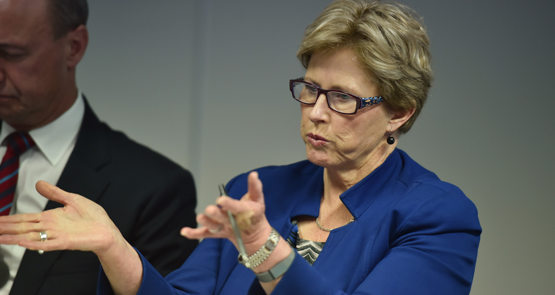For the second time in three years, the Greens have sprung a leadership surprise on Canberra, with Christine Milne announcing her retirement from politic this morning.
Victorian Senator Richard Di Natale was elected leader in a party room ballot unopposed, with Scott Ludlam and Larissa Waters becoming co-deputy leaders.
Just over three years ago, Bob Brown retired as leader in a surprise announcement, paving the way for long-time deputy Milne to replace him. Milne’s retirement bring to an end a quarter century in parliamentary politics: she was first elected to Tasmanian Parliament in 1989, led the Tasmanian Greens in supporting a Liberal minority government after 1996, lost her seat in 1998 and became an adviser to Brown, by then in the Senate, until she became the second Tasmanian Greens Senator in 2004. She has led her party at both the state and federal level — a unique achievement.
Senior Greens figures said that Milne was likely to be a transitional leader for the Greens, with few expecting her to stay in the job for an extended period. That has turned out to be the case. But Milne, who had a decidedly harder-edged style than Brown, played an important role in ensuring the departure of Brown — well-known across the country and acknowledged even by his political opponents as a man of integrity and principle — didn’t damage the Greens.
Under Brown, and courtesy of the deep electoral disillusion created by the circumstances of the 2010 election, the Greens dramatically increased their parliamentary presence, with nine senators and the party’s second lower house seat and first at a general election. In the wake of his departure, the Greens’ national vote sagged and party underperformed in state elections and byelections, but Milne was able to retain all of the 2010 federal gains in 2013 — an unlikely achievement given the landslide to Tony Abbott. Adam Bandt’s seat of Melbourne was held against Labor, courtesy of a huge spending campaign, a second Victorian senator was added (Janet Rice) and Peter Whish-Wilson, Brown’s replacement (and mooted as an eventual long-term leader), held on in Tasmania. In the west, Scott Ludlam actually lost his spot before narrowly winning on a recount, and then turned the WA Senate byelection into a Greens triumph, with the party picking up over 15% of the vote.
Milne’s time as leader wasn’t without dissension, something almost unknown under her predecessor, who led a far smaller party for most of his time as leader than Milne, who has had an 11-member party room since last July. The issue of fuel excise indexation almost opened a rift within the party, and there has been regular sniping from within at the high-profile Sarah Hanson-Young, including on the party’s policy stance on asylum seekers. But the much-foreshadowed clash between the more hard-Left NSW Senator Lee Rhiannon and Milne never eventuated (in fact, News Corp attempts to play up Rhiannon into some hardline Trotskyite monster have gone nowhere). Indeed, the sheer maladroitness of the Abbott government’s performance has made it considerably easier for the non-government parties, despite their successful blocking of nearly all of the controversial measures of last year’s budget. Currently the party is performing strongly, consistently reaching a 10% primary vote.
Milne’s policy legacy is less clear. It was Milne who had been instrumental in pushing the Gillard government to the establishment of a carbon price, announced in 2011, which precipitated the collapse in Gillard’s political fortunes, not helped of course by relentless undermining by Kevin Rudd. But the carbon pricing scheme that resulted was a quality policy — a low-impact, effective model that reduced emissions with virtually no economic disruption, until abolished by the denialist Abbott government.
Like her long-time state and federal colleague Brown, Milne is leaving her party in good shape. On current polling, the Greens may well have peaked, electorally — at the next election (if it’s not a double dissolution), they are likely to lose Larissa Waters’ Queensland spot and may struggle to keep Rhiannon in NSW and Penny Wright in South Australia, but many of us thought they had peaked when Brown left, and Milne proved us wrong. Whether Di Natale can do the same will be a significant issue between now and the next election.









Christine went at the right time, as you say, from a position of strength. She was tough and very intelligent (read her speeches) and was improving as a spokesperson. I suspect she’d been having some voice modulation lessons.But a good time to go. Let’s see how Dr Di Natale takes over.
The Greens have a Party Room full of intelligent, compassionate people of integrity and principle. It is a talent pool the other parties could only dream of (I have often thought that the hardest task in Australian politics for a talented person would be to win pre-selection for the Greens in a winnable spot). Well done to Christine Milne for her leadership and for allowing for a smooth transition to the next generation.
I confess I had my money on Scott Ludlum but Dr Di Natale is an excellent choice and has authority on medical policy that the other parties can only dream of. Given it is one of the most critical areas of government, hopefully he can improve the Greens standing in the next federal election. Best of luck to Christine and I wish her well
Civilised Greens passing the baton without rancour. Pity the others cant forget their egos for a moment and start governing for the people instead of jockeying and back stabbing for position.
Why is Milne departing, & why only ‘expected to be a transitional leader’?
I wasn’t a fan of Ms Milne initially (i struggle with my prejudice against xtians), but can’t fault her performance in the job. She was even eroding the pavlovian hatred that makes many rural males so ridiculous.